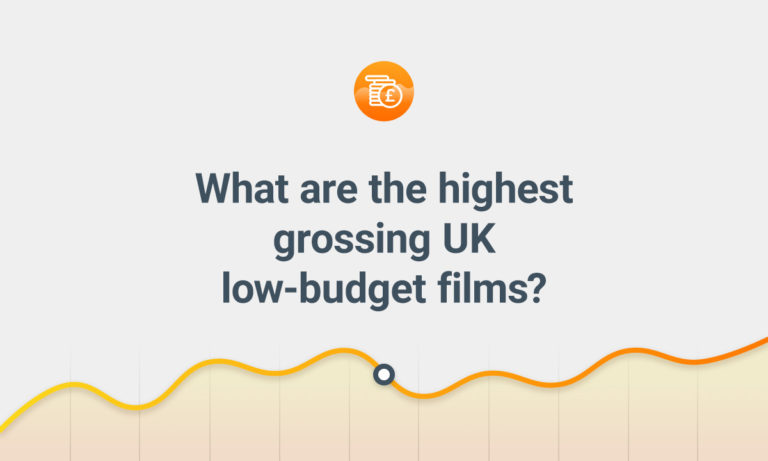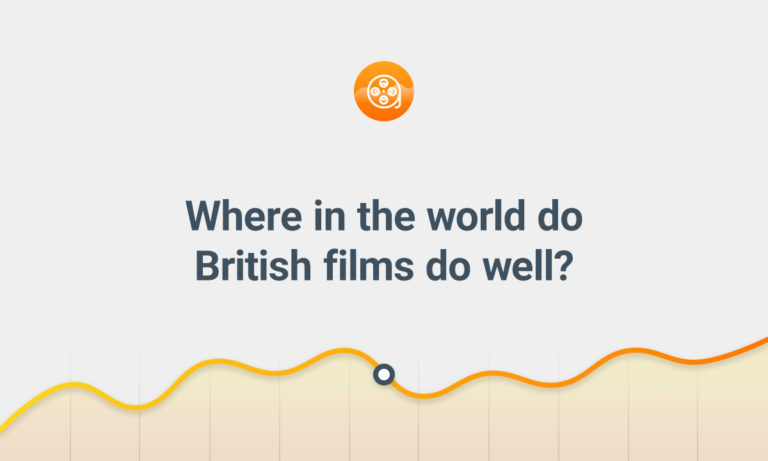 Today’s research started out as a simple investigation into what percentage of UK films are dramas but quickly descended into exploring the meaning of genre.
Today’s research started out as a simple investigation into what percentage of UK films are dramas but quickly descended into exploring the meaning of genre.
In the distribution world it’s often said that “drama is not a genre”. This means that most genres provide the audience with a clearly defined expectation of what the film will be before they see it. However, saying that a film is a drama doesn’t give us anything to go on when assessing what it may involve. Most dramas are either star-driven or ‘execution dependent’ (i.e. they have to be good and get great reviews to have any hope of attracting an audience).
Despite this, a huge number of the films we make in Britain are dramas. I’ve written before about why this might be, so I won’t go into detail. Suffice it to say I feel it comes down to a combination of our literary past, our cash-strapped present and our semi-European disdain for commerciality. I am not saying that it’s good or bad, but simply noting our tastes as a filmmaking nation.
I decided to drill into this drama obsession a little deeper and it proved trickier than I expected. In summary…
- 18.5% of the films made in the UK from 2011-13 were dramas
- Dramas account for just 9.8% of the total amount spent on UK films
- 12.2% of the UK films in cinemas are dramas
- But they account for just 0.5% of the box office gross for UK films
- The average budget for a UK drama film between 2011-13 was £3.1 million
- The average gross for UK drama films 2011-13 was £380,000 – just 12% of the average budget
What genre do British filmmakers make most often?
Drama is the most popular fictional genre for UK filmmakers. According to the BFI’s Statistical Yearbook, 18.5% of the films made in the UK 2011-13 were dramas.
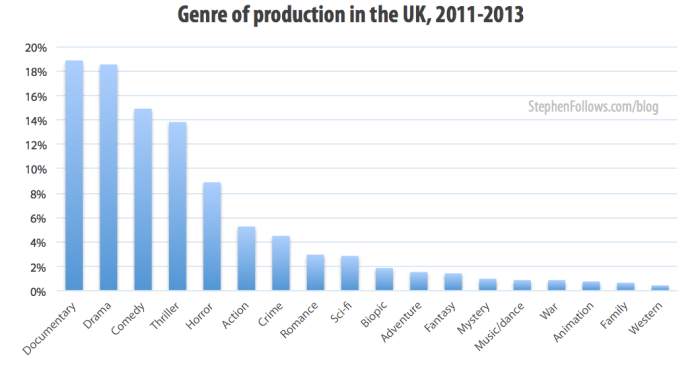
So do we spend most of our budgets on dramas?
Not at all. When we overlay the amount of money spent on film budgets over the same period we can see that dramas account for just 9.8% of the total amount spent on UK films.
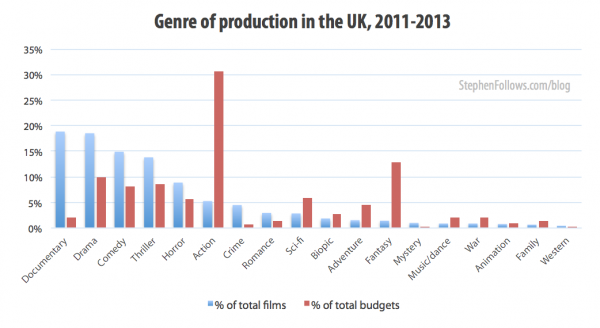
In fact, the average budget for a UK drama film was £3.1 million.
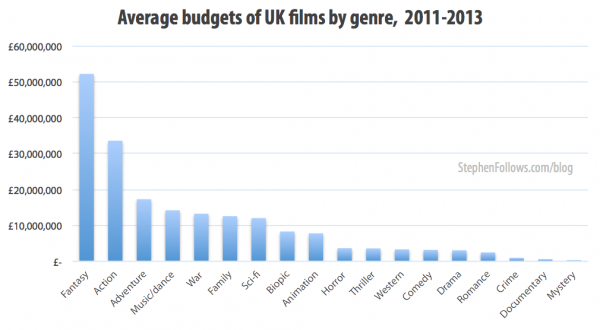
Do UK audiences like dramas as much as British filmmakers?
Out of all the UK films in cinemas in 2013, drama was the least popular genre. Despite 12.2% of the UK films in cinemas being dramas, they accounted for just 0.5% of the box office gross for UK films.
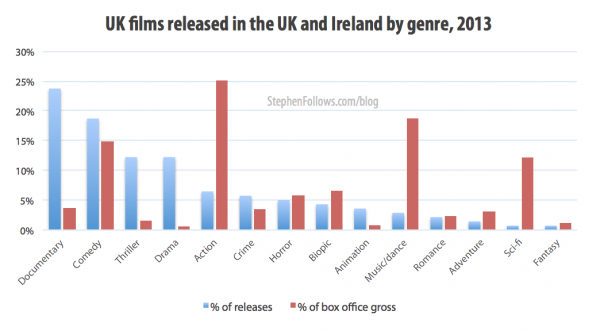
(Note: The huge box office for “music / dance” in 2013 is largely down to one film – Les Miserables).
That’s an average gross of £380,000 – just 12% of the average amount spent on UK dramas over the same period (as shown above).
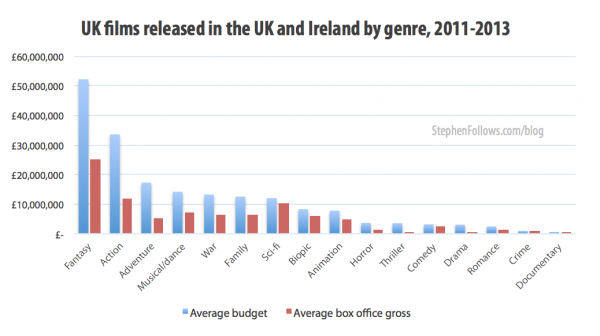
What is a genre, anyway?
There are no “official” genre classifications, meaning that each organisation within the film business has to make their own decisions as to how they will group films. And genre is a harder attribute to measure than it at first seems. Complicating factors include…
- Number of genres – Films like ‘Dusk Till Dawn’ defy any single classification so it makes sense to allow films to have more than one genre. However, then the question becomes – how many genres per film? It’s easy to say that ‘Interstellar’ is a sci-fi film but is it also a drama? And what about it being an action film?
- What does the genre apply to? – The majority of genres relate to the film’s story (i.e. comedy, action, romance) but some genres refer to production method (i.e. animation, documentary) and others refer to film’s intended audience (i.e. family).
- Weighting – ‘Barton Fink ‘ is both a comedy and a drama, but which is the more important genre?
- Subdivision – It’s possible to subdivide films into much more specific niche genres, such as horror into psychological horror, supernatural horror, etc.
- Extremely broad – Naturally, when you group all films made into a small list of classifications you end up with some strange bedfellows. ‘Shaun of the Dead’ and ‘Human Centipede’ are both horror films, but one would presume that their audiences are pretty different.
For today’s research I have been using the BFI’s definition of a film’s “primary genre”. They say…
For statistical purposes, the BFI Research and Statistics Unit assigns a primary genre to every film released in the UK. This is not meant to be prescriptive but helps gauge the relative popularity of different genres on a consistent basis from year to year. The list of genres is based on conventions commonly used within the industry and by published sources such as the BFI’s Collections Information Database, the British Board of Film Classification (BBFC) and the Internet Movie Database (IMDb).
Trying to gather low-budget UK film genre data
In order to break the statistics down further (i.e. by budget range) as I normally do, I needed to re-create the BFI’s classification of primary genre. This proved very tricky as most sources assign multiple genres per film, and are highly subjective.
Initially I opted for IMDb’s genre classifications as they seemed to have the most rigorous and transparent system for defining a film’s genre. IMDb assigns up to three principle genres per film and lists them in alphabetical order (rather than weighing the three genres). However, I found that IMDb is very quick to label films as a drama. The list of UK films which IMDb claims to be a drama includes…
 Four Lions
Four Lions- Arthur Christmas
- StreetDance 3D
- Anuvahood
- StreetDance 2
- Moon
Many of these films have dramatic elements because, let’s face it, so does almost everything in life. But I don’t feel that labeling them as dramas is quite representative of how the general public views these films.
So I cast my net a bit wider and compared genre data for UK low-budget films across four organisations…
- IMDb – The three main genres on a film’s IMDb listing (average of 1.7 genres per film)
- BFI – The production tracking database of films made in the UK (average of 1.6 genres per film)
- Rentrak – Box office data tracking (average of 1.5 genres per film)
- Rotten Tomatoes – RT measures audiences’ and critics’ views of films (average of 1.8 genres per film)
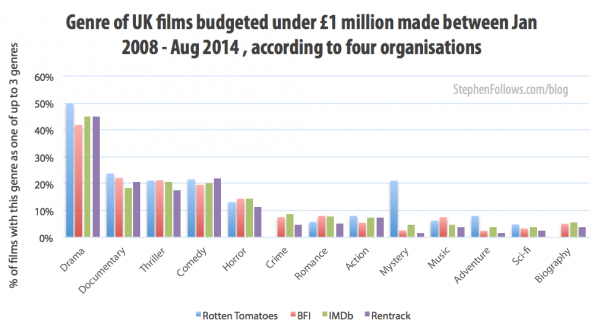
Epilogue
The data for the first few charts came directly from the BFI Statistical Yearbook 2013, then I started number crunching with the figures (to produce averages and comparisons) and finally the last chart came from primary research on IMDb, production data given by the BFI, Rentrak box office data I purchased and Rotten Tomatoes via their API.
 One of the most fun things about looking at film data is mixing data that is easy to quantify (such as how a film performed in cinemas) with more vague artistic data points (such as the creative content of the film). Today’s genre research has been exactly that kind of a challenge.
One of the most fun things about looking at film data is mixing data that is easy to quantify (such as how a film performed in cinemas) with more vague artistic data points (such as the creative content of the film). Today’s genre research has been exactly that kind of a challenge.
And finally…. last Friday we were filming in a cancer research lab and so all of our crew had to wear white coats. It struck me that if I was a more committed film-data-scientist then this is how I would dress every day.


